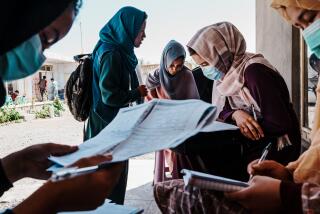Afghanistan strategy should also focus on improving quality of life
- Share via
The Obama administration has outlined a three-pronged strategy in Afghanistan, focusing on security, governance and economic development. But the implementation of those elements has been woefully lopsided. Since 2002, 93% of the $170 billion the United States has committed to Afghanistan has gone to military operations.
As the country prepares to send 30,000 more troops to Afghanistan, we also need to focus on providing a surge in the quality of life for the Afghan people.
U.S. Agency for International Development workers are tremendously dedicated, but there are not nearly enough of them, which means the agency is heavily dependent on private contractors. There have been some commendable achievements, such as helping reduce Afghanistan’s infant mortality rate and rehabilitating nearly 1,000 miles of roads. Still, as Secretary of State Hillary Rodham Clinton lamented in March, the lack of results for the Afghan people is “heartbreaking.”
The Obama administration has pledged a new, improved approach to development aid. Yet USAID has been without an administrator for 10 months, and the president’s nominee, Rajiv Shah, has yet to be confirmed. It’s now time, with the president’s commitment in his West Point speech to “focus our assistance in areas, such as agriculture, that can make an immediate impact in the lives of the Afghan people,” to heed the experience of successful social entrepreneurs who, with far fewer resources at their disposal, have achieved impressive progress on the ground.
Take Greg Mortenson, president of the nonprofit Central Asia Institute, or CAI, who over the last 16 years has built or supported 130 schools in remote Pakistani and Afghan villages. These secular schools provide education to more than 30,000 children, the vast majority of them girls. CAI’s revenue in fiscal year 2007 were a fraction of what we will spend every day in Afghanistan over the next 18 months.
Or take Sakena Yacoobi, a U.S.-educated public health professional, who returned to her homeland in the 1990s to found the Afghan Institute of Learning, or AIL, now a network of 45 centers in seven provinces that provide comprehensive health and education services. Seventy percent of AIL’s staff of more than 400 is female. With an annual budget of $1 million, AIL reaches more than 350,000 Afghan women and children.
Or Connie Duckworth, a former partner at Goldman Sachs, who was so moved by the hardships of the women she met on a visit to Afghanistan in 2002 that she created Arzu -- which means “hope” in Dari -- a rug-making enterprise focused on female weavers that is one of Afghanistan’s largest private-sector employers, with 90% of its jobs in underserved, rural areas.
What are some key lessons from these social entrepreneurs’ success? First, ask, don’t tell: U.S. assistance programs must be tailored to meet local needs, not our own. Over the last eight years, too many well-intentioned U.S. programs have been driven by what America thinks is best, which is how we wasted millions trying to launch a 25,000-acre plantation on soil that was too salty for crops, and initiating cash-for-work construction of cobblestone roads that Afghans rejected because they hurt their camels’ hooves. The Afghan people know what they need. Second, invest capital outside the capital -- and devise and direct those projects from the field. Mortenson is successful in part because he spends months every year living with the villagers in the communities his organization serves. That model has not yet penetrated the thinking of U.S. government programs. As Amy Frumin, who served as a USAID worker in Panjshir province, wrote in a June 2009 report for the Center for Strategic and International Studies: “The vast majority of USAID funds are invested in programs that are designed from Kabul” -- even though more than three-quarters of Afghans live outside the capital. Third, ensure that U.S. assistance reaches the Afghan people. This sounds obvious. Yet last year, the nongovernmental Agency Coordinating Body for Afghan Relief reported that 40% of official aid to Afghanistan goes back to donor countries in corporate profits and consultant salaries. Fourth, make women the focus, not the footnote, of aid programs. It’s no accident Mortenson, Yacoobi and Duckworth all target their limited resources toward women and girls: In Afghanistan, as elsewhere, investing in women pays dividends many times over. Women are more likely to prioritize the education, nutrition and health of their families, creating a multiplier effect that lifts entire communities. Finally, approach development as an evolution, not a revolution. As Afghan expert Rory Stewart recently argued in a PBS interview, “Afghanistan is very poor, very fragile, very traumatized. To rebuild a country like that would take 30 or 40 years of patient, tolerant investment.”
We should invest in programs that will be sustainable, long-term -- and be prepared to commit for the long haul.
Mortenson called his book “Three Cups of Tea” in reference to a rural village leader’s advice that slowing down and building relationships over tea in the traditional way is as important as building projects. As 30,000 more U.S. troops prepare to depart for Afghanistan, let’s hope we also have the stomach for 30,000 cups of tea.
Stanley A. Weiss is founding chairman of Business Executives for National Security, a nonpartisan organization based in Washington.
More to Read
Sign up for Essential California
The most important California stories and recommendations in your inbox every morning.
You may occasionally receive promotional content from the Los Angeles Times.










